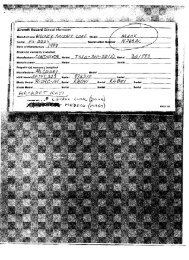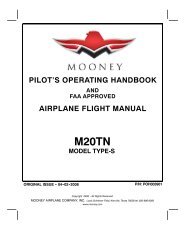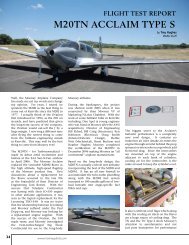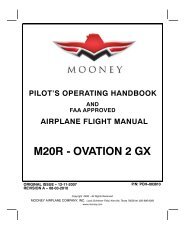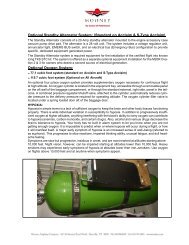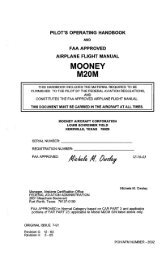M20R 3810 Rev A page.. - Delta Aviation LLC
M20R 3810 Rev A page.. - Delta Aviation LLC
M20R 3810 Rev A page.. - Delta Aviation LLC
You also want an ePaper? Increase the reach of your titles
YUMPU automatically turns print PDFs into web optimized ePapers that Google loves.
MOONEY<br />
<strong>M20R</strong> - OVATION 2 GX<br />
SECTION VI<br />
WEIGHT AND BALANCE<br />
LOADING CALCULATION PROCEDURE<br />
PILOT’S LOADING GUIDE<br />
Proper loading of the aircraft is essential for maximum flight performance and safety. This<br />
section will assist you in determining whether the aircraft loading schedule is within the approved<br />
weight and center--of--gravity limits.<br />
To figure an actual loading problem for your aircraft, proceed as follows:<br />
Step 1. Refer to the latest entry on <strong>page</strong> 6--6 for the current empty weight and moment.<br />
NOTE:<br />
Since the engine oil is normally kept at the full level, the oil weight and moment is<br />
included in basic empty weight and is constant in calculating all loading problems.<br />
Step 2. Note the pilot’s weight and the position his seat will occupy in flight. Find this weight on<br />
the left scale of the Loading Computation Form (<strong>page</strong> 6--9) and cross the graph horizontally to<br />
the graph for #1 and #2 seats. When this point is located, drop down to the bottom scale to find<br />
the value of the moment/1000 due to the pilot’s weight and seat position.<br />
Repeat procedure for co--pilot and enter these weights and moment/1000 values in the proper<br />
sub--columns in the Problem Form on <strong>page</strong> 6--8/9.<br />
Step 3. Proceed as in Step 2 to account for the passengers in seats 3 and 4. Enter the weight and<br />
value of moment/1000 in the proper columns.<br />
Step 4. Again proceed as in Step 2 to account for the amount of fuel carried, and enter the weight<br />
and moment/1000 values in the proper columns.<br />
Step 5. Once more proceed as in Step 2 to account for the baggage to be carried and enter the<br />
figures in the proper columns.<br />
Step 6. Total the weight columns. This total must be 3368 Pounds (1528 Kg) or less. Total the<br />
Moment/1000 column.<br />
DO NOT FORGET TO SUBTRACT NEGATIVE NUMBERS.<br />
Step 7. Refer to the Center--of--Gravity Moment Envelope (<strong>page</strong> 6--10). Locate the loaded<br />
weight of your airplane on the left scale of the graph and trace a line horizontally to the right.<br />
Locate the total moment/1000 value for your airplane on the bottom scale of the graph and trace<br />
a line vertically above this point until the horizontal line for weight is intersected. If the point of<br />
intersection is within the shaded area, your aircraft loading is acceptable. If the point of intersection<br />
falls outside the shaded area, you must rearrange the load before take off.<br />
ORIGINAL ISSUE - 12-11-07<br />
AIRPLANE FLIGHT MANUAL<br />
6--7



